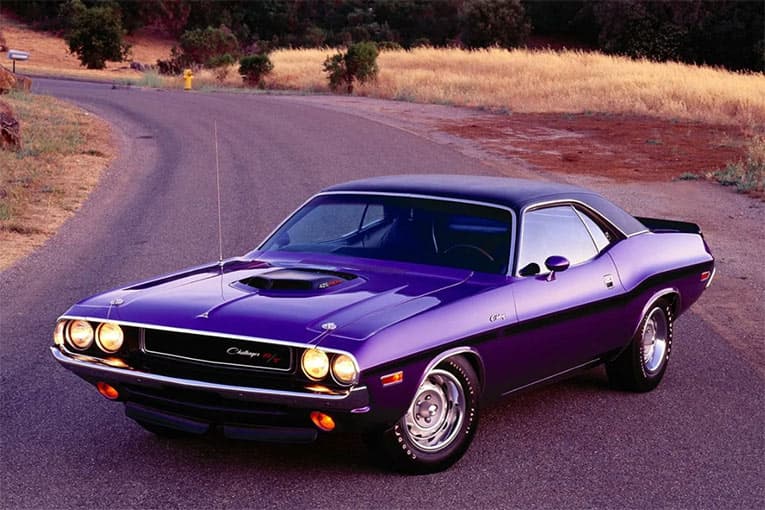When the Dodge Challenger first entered in the muscle car ranks of Detroit’s Big Three, it arrived with something its competitors didn’t have: the greatest range of powertrain choices in the industry, from the small but durable 225-cubic-inch “Slant Six” to the fearsome “Elephant Motor” — the 426 HEMI®. With the best muscle-car powertrains in the business, Dodge Challenger has added, and continues to add, to its rich legacy, creating one of the most storied nameplates in automotive history.
1970
The Dodge Challenger made its debut in the fall of 1969 as a 1970 model. While it shared Chrysler’s “E-body” short-deck, long-hood platform with the third-generation Plymouth Barracuda, Dodge Challenger’s wheelbase was 2 inches longer, creating more interior space. The Dodge Challenger was originally offered as a two-door hardtop or convertible, in base, SE (Special Edition), R/T (Road/Track) and T/A (Trans-Am) trim. But it was the range of powertrain choices that was truly remarkable:
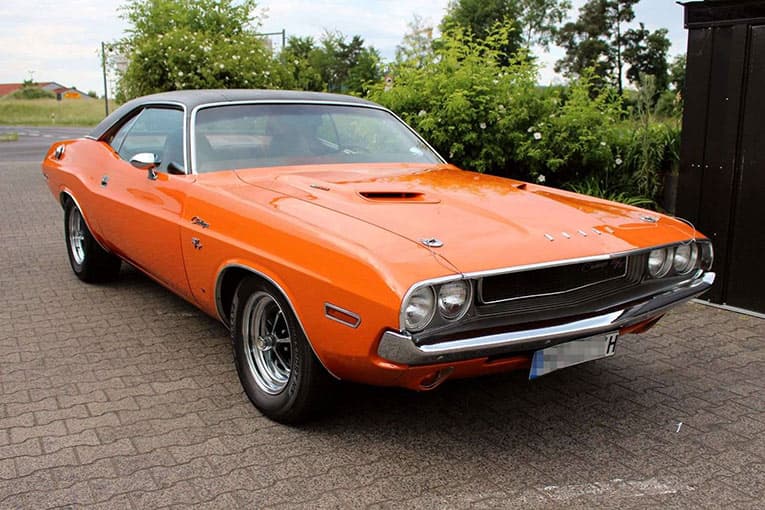
- 225-cubic-inch I-6; 145 horsepower
- 318-cubic-inch V-8; 230 horsepower
- 340-cubic-inch V-8; 275 horsepower (290 horsepower in the T/A)
- 383-cubic-inch V-8; 290 horsepower
- 383-cubic-inch V-8; 330 horsepower
- 383-cubic-inch V-8; 335 horsepower
- 426-cubic-inch HEMI V-8; 425 horsepower
- 440-cubic-inch V-8; 375 horsepower
- 440-cubic-inch V-8; 390 horsepower
Driveline choices for various engines included Chrysler’s TorqueFlite automatic transmission and a three- or four-speed manual transmission, which could be equipped with a Hurst “pistol-grip” shifter. Big-block Challengers could be ordered with a heavy-duty Dana 60 differential equipped with a limited-slip differential. Even the paint schemes said “performance,” with colors, including Plum Crazy and HEMI Orange, accented with “bumblebee” stripes. Customers could further customize their cars with twin-scooped hoods, “shaker” hoods and deck-lid wings. Befitting the brand’s performance heritage, Dodge raced the Challenger in its first year on the market. For the street, it was offered in the limited-edition T/A model to meet homologation requirements for Sports Car Club of America (SCCA) Trans-Am racing. The T/A was one of the first production vehicles to offer staggered size tires in the front and back; E60 x 15-inch front and G60 x 15-inch rear. In 1970, Sam Posey drove the lone Trans-Am racing Challenger, prepared and run by Ray Caldwell’s Autodynamics Race Shop. While he didn’t win a race in the No. 77 car, Posey finished fourth overall in points. Drag racers, including Dick Landy and Ted Spehar, also campaigned Challengers in the National Hot Rod Association’s new Pro Stock class. In 1970 and 1971, the HEMI-powered Challengers (and Plymouth ‘Cudas) virtually ruled the class.
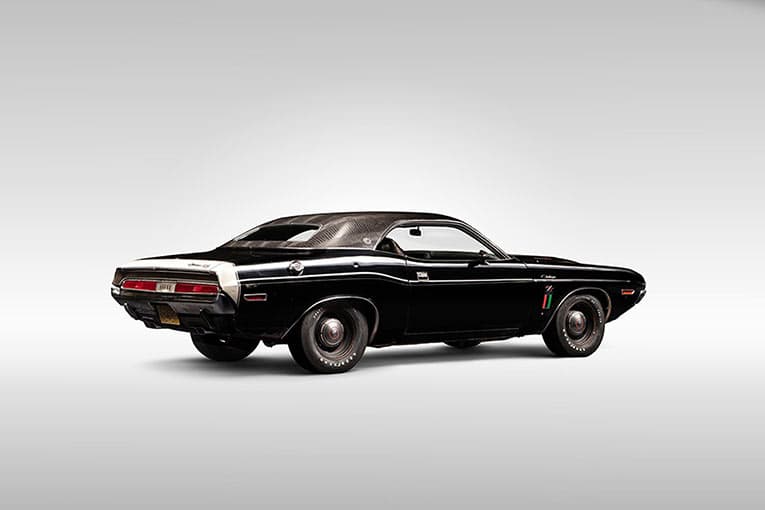
On the big screen, a 1970 Challenger R/T starred in the film Vanishing Point, a high-speed pursuit movie that has become a cult favorite with muscle-car fans. The movie was remade for television in 1997. Other 1970 Dodge Challengers have been seen in films, including Used Cars, Natural Born Killers and Phantasm I and II; and in television shows, including Mod Squad. For the 1970 model year, more than 83,000 Dodge Challengers were sold.
1971
In 1971, designers made subtle styling changes to the Dodge Challenger, providing new treatments to the taillamps and grille. The single-taillamp design from 1970 became two distinct lights for 1971, and a new-for-1971 twin-inlet Challenger grille was painted silver on standard models and black on R/Ts. Challenger R/T models also received a set of fiberglass quarter-panel louvers. An additional coupe model with fixed quarter windows was added to the lineup. As in 1970, a wide range of trim levels, exterior colors and striping options made the Dodge Challenger easy for customers to create a special car. However, for 1971, Dodge dropped the T/A (it was no longer racing in Trans-Am), SE models and R/T convertible.
New EPA emission standards led to some powertrain changes; the optional 375 horsepower 440-cubic-inch was eliminated, as was the Six Pack-equipped 340-cubic-inch powerplant. The 383-cubic-inch Magnum engine was detuned to 300 horsepower by lowering the compression ratio for improved emissions. However, a 390 horsepower six-pack 440 V-8 was available, and the 425 horsepower 426-cubic-inch HEMI still topped the vast engine offerings. A Dodge Challenger paced the Indianapolis 500 race in 1971. Dodge produced 50 Challenger convertible pace car replicas — all painted HEMI Orange with white tops and interiors.
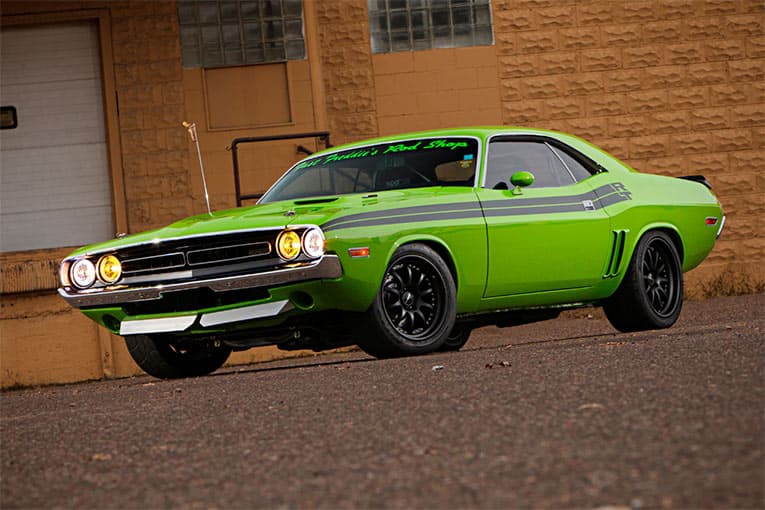
1972
With escalating insurance rates and new EPA emissions mandates, more changes came to the Dodge Challenger in 1972. Also, the Society of Automotive Engineers (SAE) revised the torque and horsepower rating test from a “gross” to a “net” as installed in the cars. This reduced all ratings 20 to 30 percent, making them non-comparable to previous ratings. Only three engines were available in the 1972 Dodge Challenger: the 225-cubic-inch Slant Six with 110 horsepower, the 318-cubic-inch V-8 with 150 horsepower and the 340-cubic-inch V-8 with 240 horsepower. All were equipped to use the then-new unleaded fuel.
With convertible sales in steady decline over several years, the 1972 Dodge Challenger was offered in hardtop form only. The sun roof had become a more popular alternative and was offered as an option for more than $400. New front-end styling in 1972 featured a larger “egg-crate” grille. It was painted argent for standard Challengers and black on the Challenger Rallye performance model, which replaced the R/T. The Challenger’s taillamp design included twin lights on each side, with the center panel painted the same color as the grille. The Rallye model also was equipped with four small scoops on the front fenders.
1973
Beginning in 1973, the federal government mandated new bumper-impact standards that resulted in the only changes to the Dodge Challenger exterior — five-miles-per-hour bumpers equipped with large rubber guards that extended out from the bodywork. Inside, grained vinyl was the only available seating material, but a new instrument-cluster design was part of the Rallye option package. The Rallye was eliminated as a separate model, although customers could create one with options. Under the hood, the six-cylinder engine was no longer available; the 150 horsepower 318-cubic-inch V-8 was standard, with the 240 horsepower 340-cubic-inch V-8 as the only option.
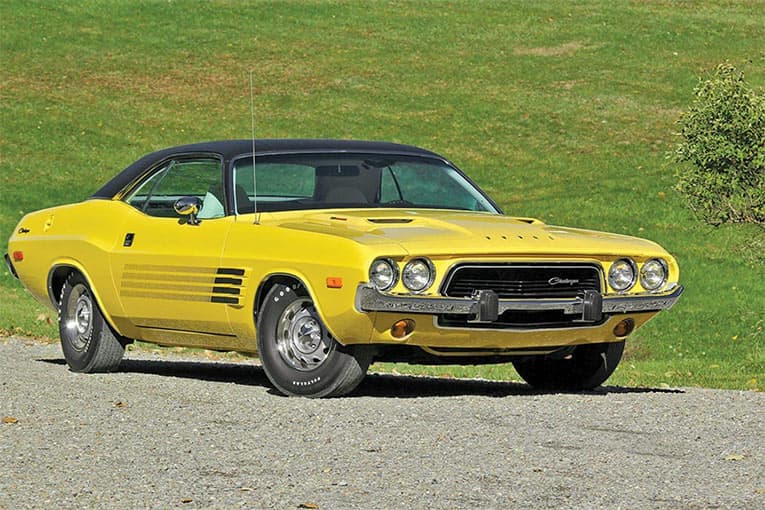
1974
With performance car insurance rates skyrocketing, more safety equipment led the short list of changes for the 1974 model-year Dodge Challengers. Inside, lap and shoulder belts were equipped with an inertia reel. In addition, there was a federally mandated seat belt-ignition interlock, which prevented the car from being started if the driver or passenger didn’t buckle up. The Dodge Challenger offered a different engine option for 1974. With the 318-cubic-inch V-8 still standard, a 360-cubic-inch V-8 producing 245 horsepower replaced the 340-cubic-inch V-8 as the only engine option. In April 1974, Challenger production ceased. During a five-year span, approximately 188,600 Dodge Challengers were sold.
1978-1984
Beginning in 1978 — the year the U.S. Corporate Average Fuel Economy (CAFE) standard took effect — Dodge offered a new Challenger two-door coupe imported from Mitsubishi. It was offered with a standard 1.6-liter, 77 horsepower I-4 engine, with a 2.6-liter, 105 horsepower four-cylinder as an option. Slightly restyled in 1981, the Dodge Challenger soldiered on until 1984, replaced by the growing stable of Chrysler Corporation’s K-platform compacts and a new import from Mitsubishi: the Dodge/Plymouth Conquest. During its six-year run, sales of the imported Dodge Challenger averaged between 12,000 and 14,000 units per year.
